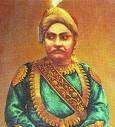Khwaja Ahsanullah
| Nawab Khwaja Ahsanullah Nawab of Dhaka | |
|---|---|
 Nawab Khwaja Ahsanullah Khan Bahadur KCIE | |
| Reign | 1896 - 1901 |
| Predecessor | Nawab Khwaja Abdul Ghani |
| Successor | Nawab Khwaja Salimullah |
| Born |
22 August 1846 Dacca, Bengal Presidency, British India |
| Died |
16 December 1901 (aged 55) Dacca, Bengal Presidency, British India |
| Burial | Begum Bazaar, Dhaka |
| House | Dhaka Nawab Family |
| Father | Nawab Khwaja Abdul Ghani |
| Mother | Ismatun Nesa |
Nawab Khwaja Ahsanullah (1846–1901), Khan Bahadur KCIE, was the Nawab of Dhaka. He was a renowned Urdu litterateur.
Early life
He was born in 1846 the son of Khwaja Abdul Ghani and Ismatun Nesa. As a young child he learned Urdu, Arabic and Persian in addition to his native Bengali. He was noted as being a very gifted child, and mastered the Koran at a young age.[1] By age 22, he handled the maintenance and expansion of the family estates.[2]
Literature
He wrote widely in Urdu under the pen name "Shaheen". Those around him noted that he had a talent for composing spontaneous poetry which generally evoked sunny imagery.[2] Much of his spare time was spent composing literature in Urdu and Persian. He published a book of Urdu poems Kulliyat-e-Shaheen which has been preserved at Dhaka University. He also published his diaries, titled Tariq-e-Kandan-e-Kashmiriya. In 1884, he started an Urdu magazine, Ahsanut Qasas, which was published in Dhaka.[1]
Philanthropy
Ahsanullah was a noted philanthropist. He donated over 5 million rupees to various charitable projects. He spent over 50,000 rupees on famine relief in Barisal District, Mymensingh District and Dhaka District in 1896. He also was one of the chief backers for the building of Comilla. Many hospitals were funded and constructed by him, including: the Patuankali Begam Hospital, Lady Dufferin Women's Hospital, and the Mitford Hospital.[1] He also spend 40 thousand rupees on creating an Engineering College in Dhaka, which is now Bangladesh University of Engineering and Technology.[3]
Islamic activities
Ahsanullah was an ardent advocate for Muslims. He created a number of mosques and madrassahs including the Madaripur and Begambari mosques and madrassas. He also restored and rebuilt over 15 dargahs and mosques. He was a member of the Central Northern Muhammadan Association and this played a large role in his works.[1] He also was an ardent supporter of the Partition of Bengal (1905) which his son Khwaja Salimullah facilitated.[4]
Awards and titles
Khwaja Ahsanullah was awarded many titles for his social and philanthropic work. Both he and his father were noted allies of the British Raj.[5]
Death
Khwaja Ahsanullah died on 16 December 1901 of heart failure.[1] The Nawab was buried in the family plot in Begumbazar.
Notes
- 1 2 3 4 5 Ahsanullah, Khwaja - Banglapedia by Mohammad Alamgir
- 1 2 Salimullah: life and work Pakistan DAWN - 30 December 2006
- ↑ Three pioneers who contributed most to Buet The Daily Star - 6 January 2008
- ↑ Squaring the imperial circle The Daily Pioneer - 30 November 2007
- ↑ Buckland 1902:1030
References
- Buckland, C.E. (1902), Bengal Under the Lieutenant-Governors; Being a Narrative of the Principal Events and Public Measures During Their Periods of Office, From 1854 to 1898., Kedarnath Bose.
| Khwaja Ahsanullah | ||
| Preceded by Nawab Sir Khwaja Abdul Ghani Mian |
Nawab of Dhaka 1896–1901 |
Succeeded by Nawab Sir Khwaja Salimullah Bahadur |